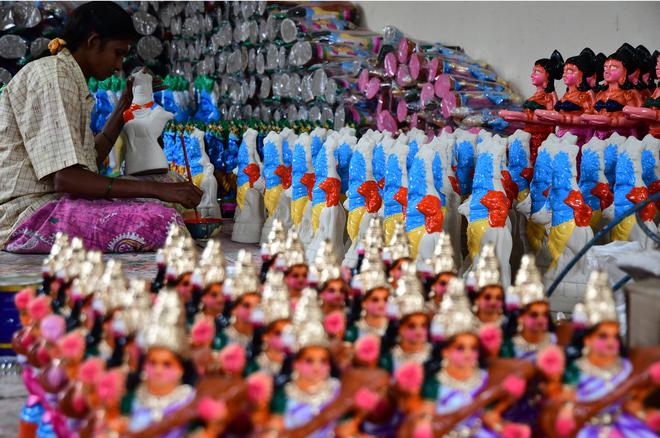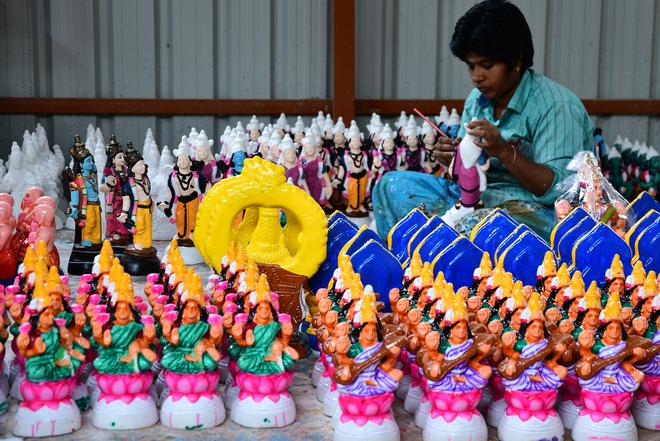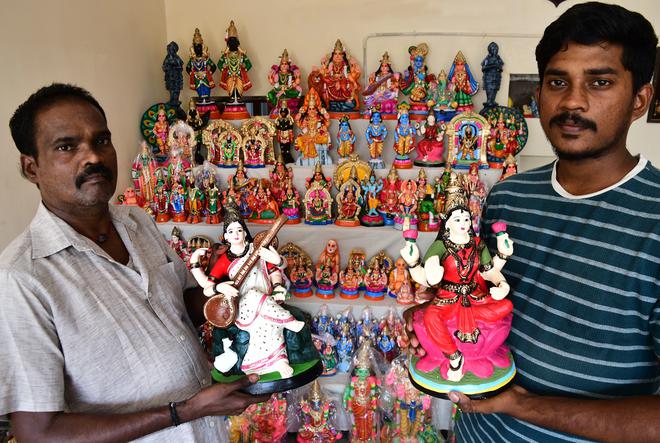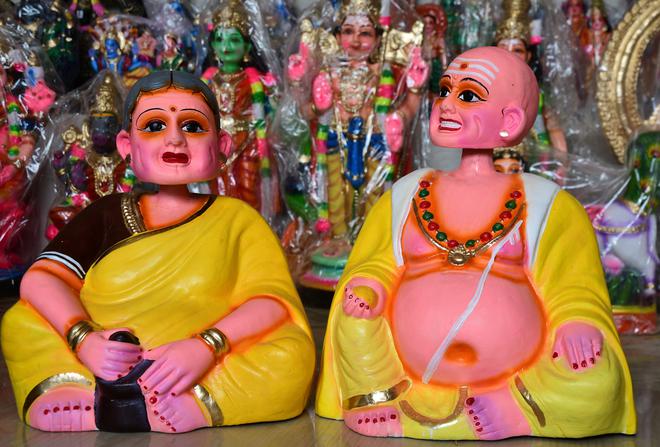Over a hundred pairs of beady eyes look at us. Some of them freshly painted, they belong to golu dolls that stand rubbing shoulders at a golu doll-making unit in Madhampatti village, 32 kilometres from Coimbatore. Inside, M Sankaralingam and his son S Jaisurya are overseeing packaging of the finished dolls. This is the busiest time of the year with Navaratri set to begin from October 15. The family has been making golu dolls for 85 years, and 26-year-old Jaisurya is from the fourth generation of artisans.
“Our ancestors worked in the temples built by Raja Raja Chola in Thanjavur,” says 53-year-old Sankaralingam, adding that they did ‘sudhai’ work. “They worked with a mixture made of kadukkai powder, limestone, clay, and karupatti to create intricate patterns on walls and pillars,” he explains.

During the British rule, they moved to Puducherry, settling at Villianur, travelling often to Madras to work at Government offices. “My forefathers worked on pieces displayed at the Ripon Building, that can be seen to this day,” explains Sankaralingam. As times changed, the artisans updated themselves to new raw materials. “My father also worked in the cinema field,” recalls Sankaralingam. “He was in the art department and built mammoth sets that featured figurines of Lord Rama and Krishna.”
These, that were made by sticking strips of paper over a bamboo structure, formed the percussor to what Sankaralingam is doing today. “His experiments paved way for us to try out paper mache dolls,” he says. These are made of a mix of powders that include limestone, Porbandar chalk powder, and paper. Jaisurya explains the process: “We have Plaster-of-Paris moulds for each deity. The first step involves pouring the liquid mixture into the mould, after which we stick strips of paper on the inside. The dolls are hollow, lightweight, and are sturdy as well,” he points out, adding that they have a team of women that hand-paints the dolls once they are dried.

Sankaralingam has over 2500 moulds, ranging from animals such as cows and Hindu deities. He works with a team of 60; has three units, including one in Pollachi where the dolls are cast. “We supply across India and also have customers abroad, including the US, UK, and Canada,” says Jaisurya. In Coimbatore, their dolls can be found at the Poompuhar and Khadi Gramodyog Bhavan outlets. “We also supply to several middlemen who buy from us in bulk and sell across the city,” he adds.

Before paper mache golu dolls gained popularity, Sankaralingam worked primarily with clay. “The joy of working with clay is something else,” he says. “I would feel nourished when my fingers crafted a clay doll, and only with clay do I feel that I have actually created something.” But he says to cater to the needs of people settled abroad, they started making lightweight dolls.
“We needed to come up with something that was biodegradable and easy to transport,” points out Jaisurya. Today, Sankaralingam holds workshops at various villages across Tamil Nadu, and has also taught people living at refugee camps at Namakkal and Paramathi Velur. “This way, they get to learn a life skill, and we get to create more artisans who can work for us,” he says.

Jaisurya posts reels on Instagram and connects with customers on WhatsApp, which helps him gain international orders. The team recently worked with the Crafts Council of Tamil Nadu to create Lakshmi, Saraswathi, and Krishna dolls inspired by Raja Ravi Varma’s paintings. “These feature subtler colours and pastel outfits, in contrast to what we usually do,” says Jaisurya, who has taken after his father after completing his Engineering.
On a metal shelf inside the workshop, Sankaralingam has displayed the popular dancing dolls of Thanjavur, some of which are over three feet tall. “There are only a handful of artisans who can make these now,“ he says. He has also preserved some clay dolls that he made years ago. “These are reminders that we once worked with clay,” says Sankaralingam.
To order, call 6379175563.







